Making a million in the cryptocurrency world is not difficult; it mainly relies on luck and opportunity, as well as your own level of control. If one day you really buy a coin that increases by a hundred or a thousand times but fail to hold onto it, then wealth will be destined to be out of your reach. I have made about 30 million in cryptocurrency trading, starting with a capital of 100,000 (to be precise, it should be 3,000), I haven't worked for nearly six years, trading full-time, with ups and downs, but the real profit came from seizing these two bull markets!
The 'crazy person' once made 110,000 in two days from 3,000; let me tell you how I made 110,000 overnight from 3,000. To be precise, it was 500U (about 3,500): I made three contracts during this process, as follows: The first one: opened a 60% position (100 times), with about 30,000U in holdings, going long on Ethereum! Coincidentally, that night, there was sudden news from a US official stating that the probability of the SEC approving ETF9 had increased to 75%. After this stimulus, Ethereum surged nearly 20% in a single day; and I happened to capture almost the entire wave, with funds soaring from 500U to nearly 6,000U. The second one: I used 6,000U to open 50% (100 times), continuing to go long, continuing to gain, and continuing to be happy! The next day, I earned nearly 1.5% (4,500U), and my principal had reached nearly 11,000U. The third one: I made a small coin BB, just at its rising channel, making a small wave! I used 11,000U to open a 20% contract (20 times), which is nearly 70,000U in holdings, earning close to 5,000U. With these three operations, I increased my 500U to 15,000U.
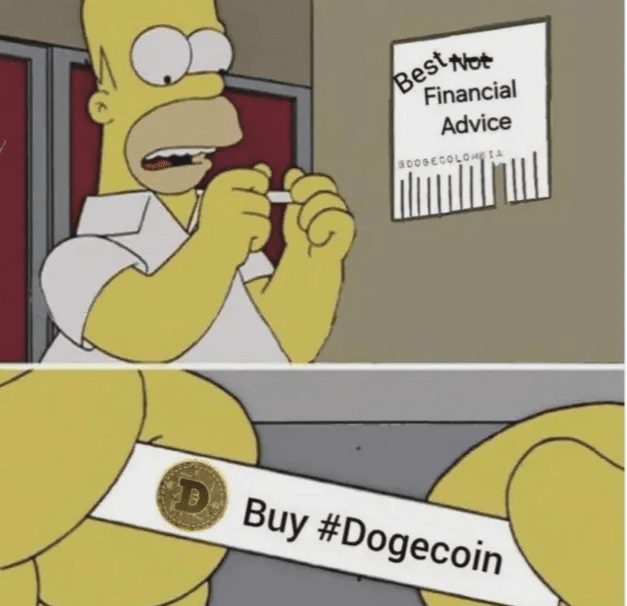
Alright, back to the point, what conclusion have I drawn?
There is a saying in the cryptocurrency world: Become a contract, lose also through contracts!
The cryptocurrency market is indeed a place where the poor can create myths and also a place where many can suddenly become wealthy overnight!
Contracts are, in my opinion, the area with the greatest risk and also the greatest opportunity. If you want to accumulate your first million in the cryptocurrency world, you must read the following suggestions!
Suggestion one: Low position and low leverage trading.
The main point of doing contracts is not how much you earn in one go, but rather to survive continuously and roll your funds, increasing them. It can be said that trading above 10,000U is certainly good, while trading below 1,000U is basically gambling; that 1,000 to 10,000U range mainly relies on technique, discipline, and mindset!
Below 1000U, there's nothing to say, just rely on a gamble!
For operations above 3000U, my suggestion is to keep the position below 1/5 and leverage below 50 times (for Bitcoin and Ethereum); this greatly reduces your risk!
As we all know, the biggest risk of contracts is liquidation, and there are many causes that can lead to liquidation, one of which is the sudden and unexplained upward or downward spikes that can easily lead to liquidation due to tight space. Therefore, it is recommended to operate within a space of over 5000 points, which makes low position and low leverage very important!
To put it bluntly, the role of low position and low leverage is to keep you alive. Staying alive gives you the opportunity!
Suggestion two: The trading frequency must be low.
The frequency of trades must be low; this is what I regard as the main principle for doing cryptocurrency trading. How low should the trading frequency be considered low? Less than twice a day (if temporarily stuck, it may take 2-3 days to trade once), reducing trading frequency has these benefits.
Benefit one: Having enough time to analyze and study each trade will greatly improve the accuracy; the reality is that many people's first trade each day often has the highest accuracy, while the more times you trade, the more likely you are to make mistakes!
Benefit two: It can avoid emotional trading; most cryptocurrency friends lose money not due to extreme market conditions, but because after trading frequently, if the error rate is high, then emotions will inevitably be serious, and in the end, the problem lies in emotions!
Benefit three: Reducing transaction fees, this goes without saying, in reality, many high-frequency traders lose more money than the transaction fees, of course, this is both yours and not yours!
Suggestion three: Avoid passionate and emotional trading.
Passionate trading and emotional trading are the two types of people who go bankrupt in the cryptocurrency world: one is unable to control their hands, and the other is unable to control their thoughts!
What are the specific explanations for the above two questions?
Passionate trading: Looking directly at 15-minute line trading; acting impulsively, feeling a market when there is a slight change, and having to trade in such situations are all passionate trading. Behind passionate trading is often the inability to control one's hand and easily getting excited, resulting in generally poor outcomes!
Emotional trading: Unable to control one's thoughts, mainly manifested in mindless resistance to positions and counter-trend trading; to be more specific, when a certain trend has clearly formed, and you are aware of this situation but are unwilling to cut losses, instead stubbornly holding on until liquidation occurs!
I define this as emotional trading; getting into a fight with oneself, always holding onto a glimmer of hope. In reality, the easiest problem to encounter in the cryptocurrency world is holding onto hope stubbornly!
Therefore, my suggestion is to be decisive!
Do not trade against the trend; when the direction is clear, you must be bold enough to cut losses; if it’s time to go, then go; if it’s time to stay, then stay; act decisively, admit mistakes, and recognize that making mistakes in one direction will certainly happen, but you cannot let the mistakes continue until the end; that would be truly finished!
Suggestion four: The risks of small markets are extremely high; I do not recommend playing small coins. As everyone knows, while small coins may be exciting, the risks are too great. You could succeed 10 times, but one mistake could lead to your downfall! Therefore, I personally do not recommend playing small coins!
Follow the public account [Crazy Person Talks About Coins], and you will definitely gain something. Helping others is like helping oneself; no matter how the market changes, I hope we can continue to walk together, smiling at the cryptocurrency world ten years later.
The 'crazy person' has unknowingly been in the cryptocurrency market for nearly ten years, transitioning from spot trading to contracts, and then back to spot, gaining rich experiences. Today, I would like to share some indicators and strategies that have benefited me greatly over the years.
The Williams index WR refers to the difference between the highest price over N days and the closing price of the day, divided by the difference between the highest and lowest prices over N days, with the result magnified by 100. It measures whether the market is in an overbought or oversold state, assisting other indicators in confirming short-term buy and sell signals. You can learn about overbought and oversold conditions through this indicator.

Simply put, it can be understood as a small moving ball bouncing up and down in a space with a ceiling above and a floor below. When the small ball hits the ceiling, it will turn back down; when the small ball hits the floor, it will bounce back up, and this small ball is the Williams indicator.
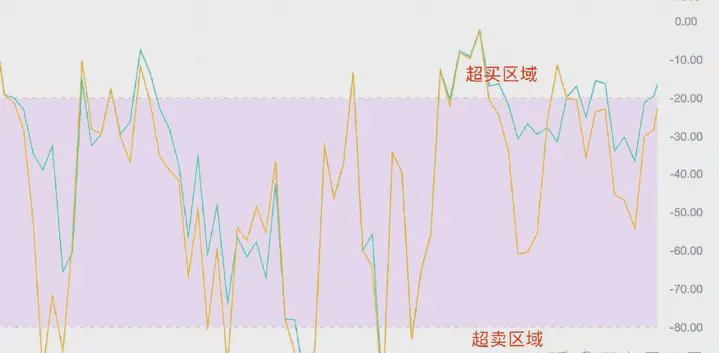
As a momentum oscillation indicator, the Williams indicator values range from 0 to -100, with -50 as the midpoint. When using the Williams indicator, it is important to focus on the -20 and -80 overbought and oversold boundary lines. When this indicator is opened, use the default parameters without additional settings. Once you understand its meaning, you can adjust it yourself.
Generally speaking, when the Williams indicator is above the -20 boundary line, it indicates that the market is in an overbought state; when the Williams indicator is below the -80 boundary line, it indicates that the market is in an oversold state.
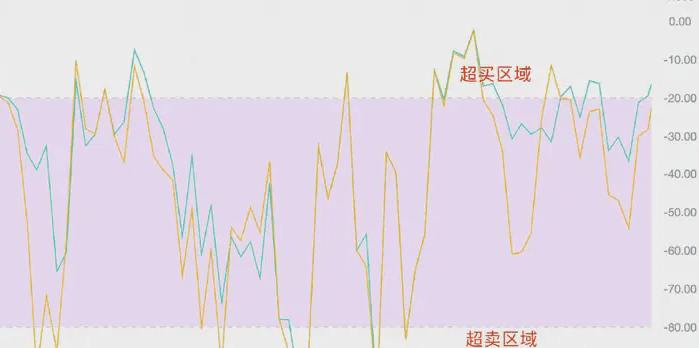
Like other technical analysis indicators, the Williams indicator can be applied to the analysis of various market cycles. The system defaults to selecting two values: 10 days and 6 days (values can be changed by yourself).
As an indicator for identifying overbought and oversold conditions, its partition is as follows:
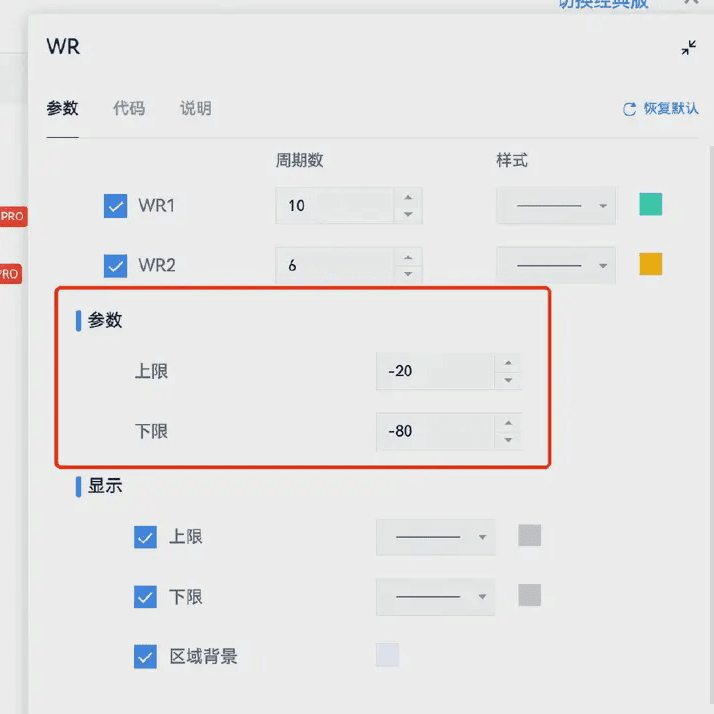
This parameter is what we present in the following chart. For example: using 0 as the top and -100 as the bottom.
(1) When the WR line starts to climb from the oversold zone and exceeds the -20 line, it indicates that the market may break upwards, which is a bullish signal.
(2) When the WR line starts to fall from the overbought zone and breaks below the -80 line, it indicates that the market may reverse downward, which is a bearish signal.
(3) The Williams indicator is an indicator that combines overbought and oversold conditions and strength differentiation.
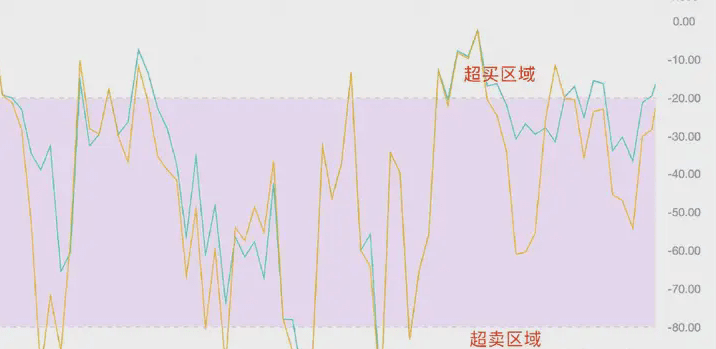
Summary: Overbought zone - bullish signal, oversold zone - bearish signal with high probability.
2. How to use the Williams indicator.
Method one: Continuous top collision. When the WR value is above -20, the Williams indicator value hits the top value of 0, that is, it collides with the top. At this point, the market is in an overbought state (key!):
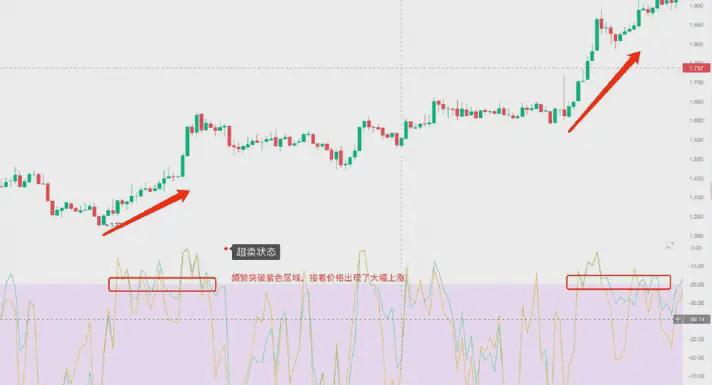
When you see the left side of the Williams indicator continuously hitting the top, the market is likely to rise afterward.
Method two: Continuous bottom collision. When the WR value is below -80, the Williams value hits the bottom value, that is, it collides with the bottom. The market is in an overbought state:
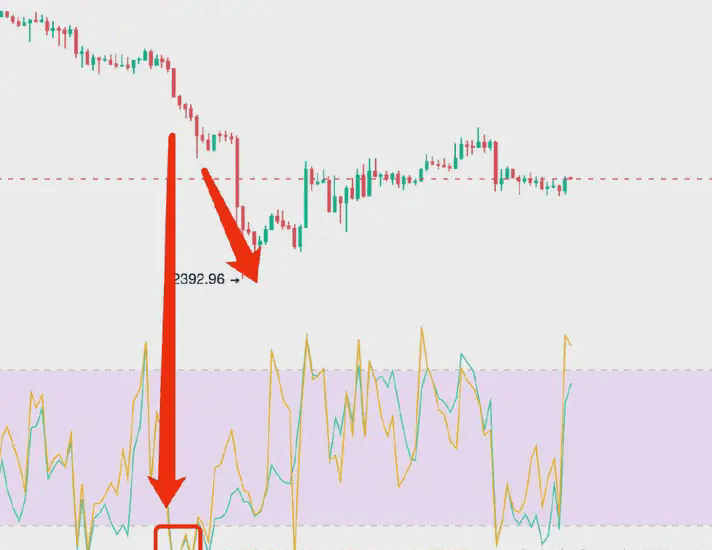
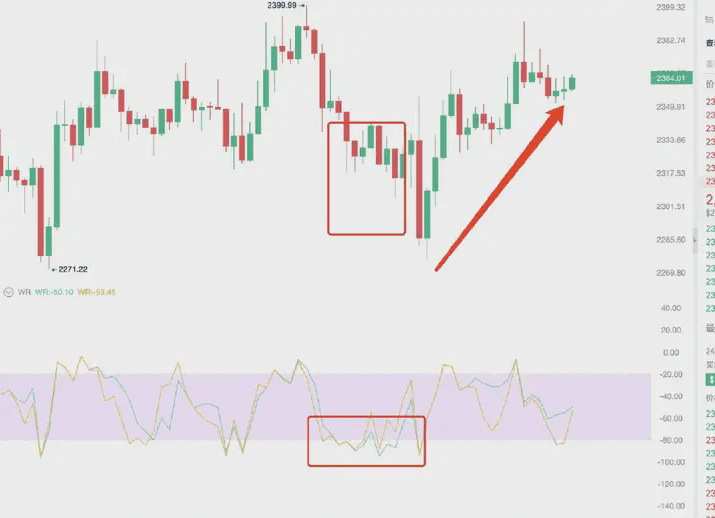
Timeframes of 1 hour, 45 minutes, and 90 minutes are all acceptable. After hitting the bottom, it may be sideways, or it may rebound sharply. Therefore, it is necessary to analyze using multiple indicators. When you combine two to three technical indicators together, accuracy will greatly improve. As an excellent investor, learning to comprehensively use several technical indicators is very necessary.
Method three: Dual line peak adhesion. Dual line adhesion refers to two indicator lines completely overlapping each other:
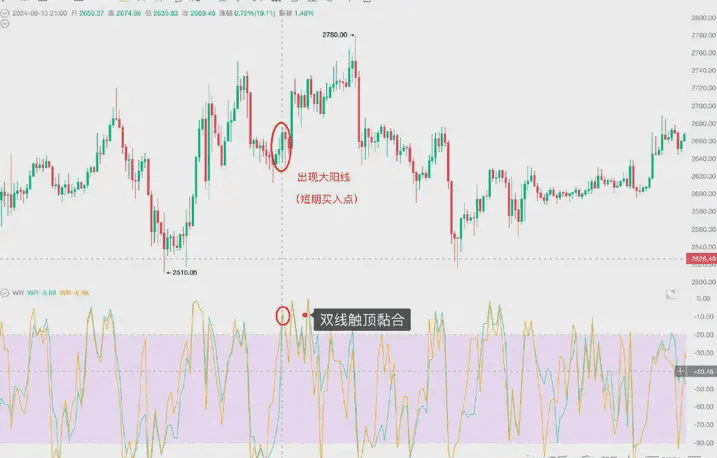
When the Williams index is in the oversold zone, and the two indicator lines adhere, if a large bullish candle appears and the index breaks below -20, it is considered a short-term buying point, and you can buy at the right time. This situation generally indicates that the short-term highest price, lowest price, and the long-term highest price, lowest price are the same, signaling that a short-term rebound is likely. When the Williams index is in the oversold zone, it indicates that the market price has dropped significantly and may reverse. If the dual lines adhere and the index breaks above -20, it means that when WR is adhering in the overbought zone, and then rebounds upwards and breaks through the -20 level, it indicates that the market may rebound from the low point. At this time, when combined with a large bullish candle, it confirms the market reversal signal and is a good opportunity for short-term buying. Therefore, it is necessary to look at multiple signals, such as a large bullish candle: when a long bullish K-line appears during the rebound process, it indicates strong buying power.
Due to the rapid fluctuation frequency of the Williams indicator, it is easy to produce errors. Therefore, combining the Williams indicator with RSI can effectively improve accuracy.
Another point we must pay special attention to is that it must be a【continuous occurrence】of hitting the top before it is a buying point.
Summary of three methods for viewing the Williams indicator:
1. Continuous top collision hitting the top -20.
2. Continuous bottom collision hitting the bottom -80
3. Dual line adhesion hitting the top/bottom.
The 'crazy person' will share five insights; these five cognitive realizations belong to the top-level design of trading, relating to principles and methods. Trading is the realization of cognition. Beyond principles and methods, there are techniques and tools; every penny earned in trading ultimately reflects cognitive realization. There are no magical techniques, only robust risk controls; keeping a close eye on risks brings you close to success.
1. About positions: Holding a good position but unable to maintain it, and holding a bad position is even worse. You must let profits run, and at the very least, do not let losses run.
2. About positions: Many people promote magical technical levels, but in reality, the truly magical factor is always the position. Knowing when to use a large position resolves the core issue in trading. Long-term investments should not be rushed; each order should not exceed one-tenth of the position; the only reason to enter the market short-term is that the market is strong; making money relies on a strong market, not on your strong abilities. Slowing down the market slightly is faster than rushing.
3. About trends: Being an enemy of the trend is dangerous, while being a friend of the trend is fatal. You are using the trend, and the trend is also using you. The essence of a bullish trend is to take you to a high position, making you feel good about yourself while buying the position. Dealing with trends is like sparring with experts; you need to remain clear-headed at all times. You can wait for the trend to establish before entering the market, but do not wait until the trend breaks before exiting; that would be too late. You can enter the market a bit late, but you must exit quickly.
4. About taking profits: Sometimes you sell too early, sometimes too late; how can you sell just right? Don't waste time on such unanswerable questions. Many people seek to sell at the peak. A world-class trading master once said, 'I make money by selling early.' Here are some profit-taking methods that I personally agree with.
The next day's closing method; if you see a profit the next day, take it.
Understanding by observing; do not sell on a bearish line; if you see a bearish line, take profits.
Do not take profits if new highs are not reached; if neither the highest price nor the closing price sets a new high, take profits.
Take profits when breaking below the moving average; the general principle is strict entry and loose exit; entry points should be strict, while exit points should be relaxed.
5. About stop-loss: I won't repeat the importance of stop-loss. Here’s a simple introduction to an effective single K-line stop-loss method: The first point of the entering K-line must not be broken, if broken, then a stop-loss must be executed. Hesitation arises from not having a clear stop-loss standard; before placing an order, you must tell yourself how much loss you might bear in this transaction. Pre-positioning your psychological framework is essential instead of asking others whether to stop-loss after being trapped; good positions can’t be held, and bad positions are even less likely to be held; that’s the basic right way.
Teaching a man to fish is better than giving him fish. Cryptocurrency investors, whether novices or experts, gain not only financial returns but also growth in investment knowledge and experience. In the process of following the 'crazy person' for investment, he will not only provide analysis ideas for the market conditions, basic knowledge of watching the market, and methods for using various investment tools, but will also bring wonderful interpretations of the fundamentals, sorting out the chaotic international situation, and distinguishing various investment influences. Let you become both a winner and an expert in investing! In the cryptocurrency market, mastering the seven trading methods will ensure that you deeply understand the ins and outs of investment, allowing you to remain steady amidst the chaos, and to turn dangers into safety in traps. Having navigated the market for many years, the 'crazy person' understands the opportunities and pitfalls within; if your investments are not going well, and you are unwilling to accept losses, you can contact the 'crazy person,' and I will correct your past; if you are currently in profit, I will teach you how to protect your profits; if you are still lost in the market, the 'crazy person' is willing to guide you forward. The real tragedy of trading is not how much you suffer, but how many opportunities you miss! Seize the present and move forward together. I am the 'crazy person,' someone who wants to leave a name in the cryptocurrency world.
Strong rebound, profits doubling! Brother Cheng will guide you in advance, winning at the starting line.
Continued attention: SPK, C
